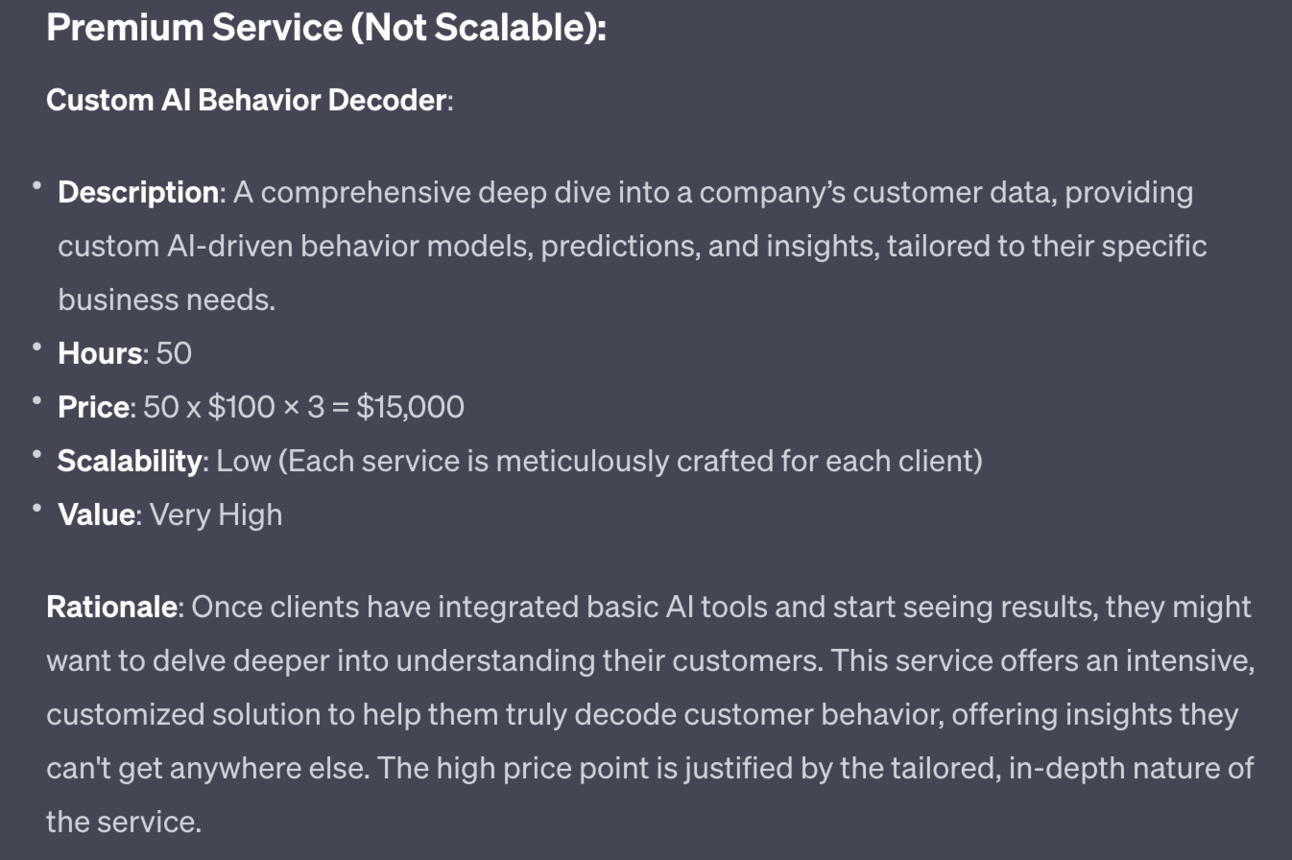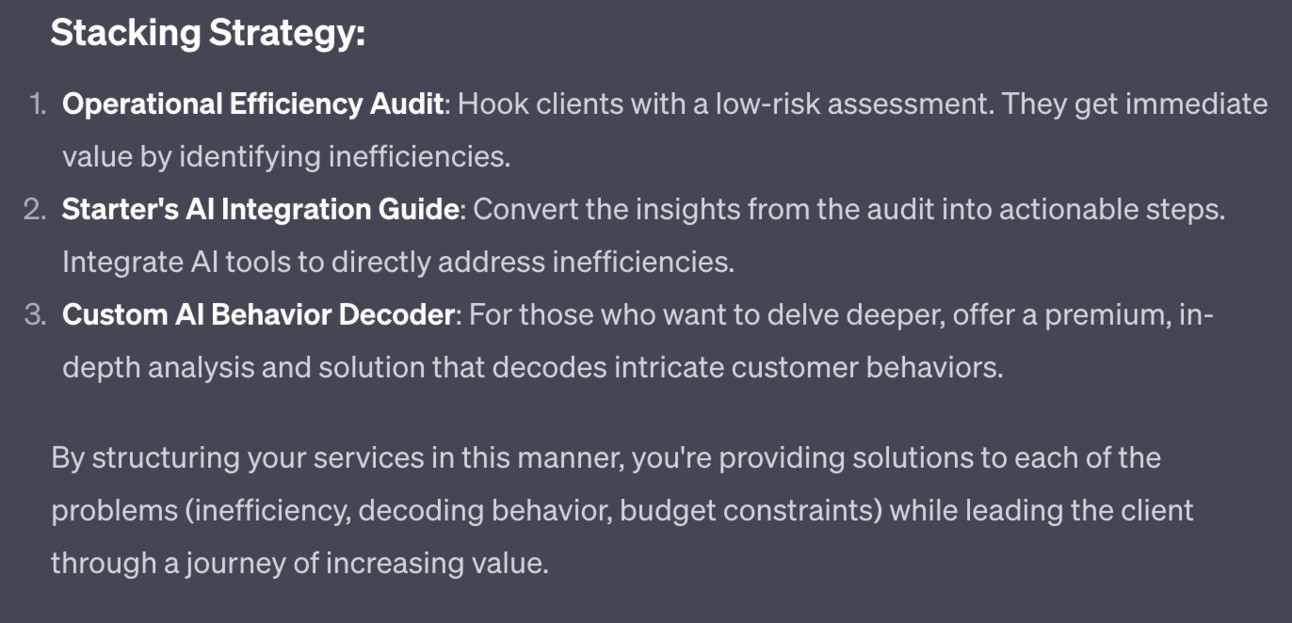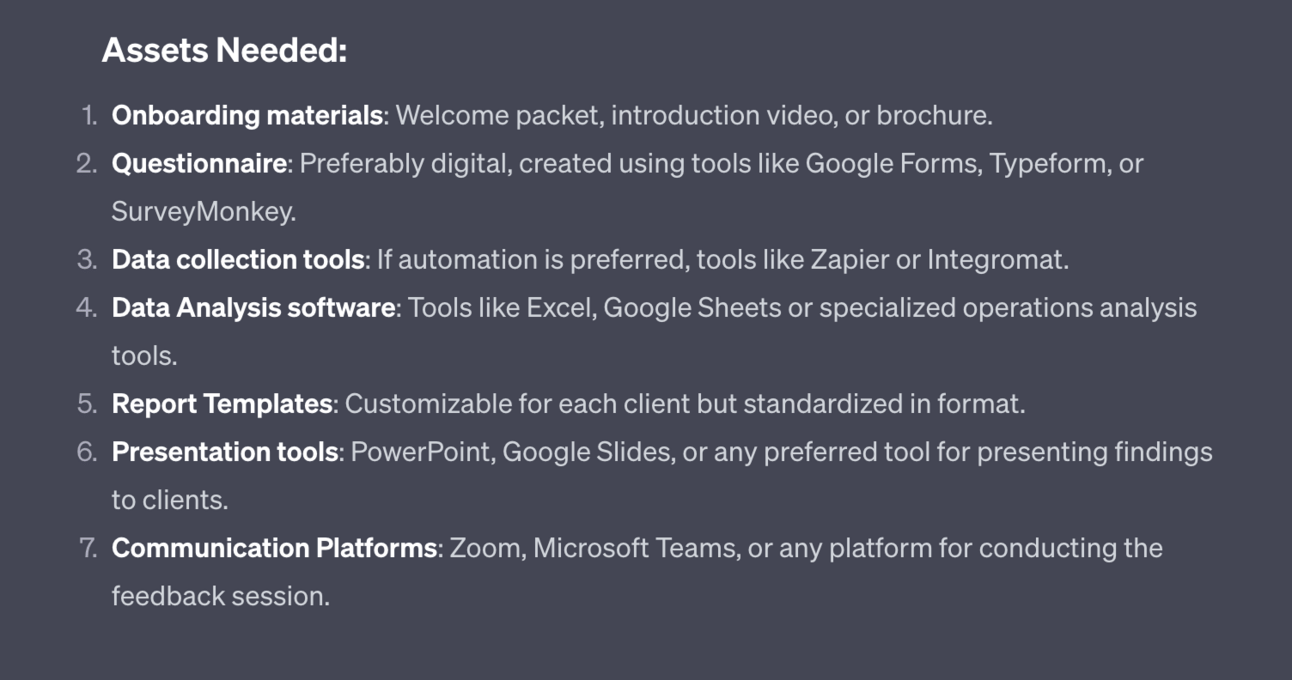Hey Prompt Entrepreneur,
In the last Part we began to identify what our service offer will be.
We’ll now take those ideas and build out your value ladder and offer stack.
By the end of this Part we’ll have our first service fleshed out and ready for release.
Let’s get started:
Design your service offer
1. Service offer stack
In the previous Part we generated a set of potential services we can provide.
Hopefully you decided on a core service out of the list – this will depend on what you feel you are best suited to deliver so combine the ideas with your own skills and experience.
We now want to generate a stack of offers from that chosen service.
For the example to follow I’ve chosen:
Starter’s AI Integration Guide:
- Description: Guided assistance for integrating basic AI tools, especially for businesses just starting on AI.
- Hours: 10
- Price: 10 x $100 x 3 = $3,000
- Scalability: High (common toolsets and platforms)
- Value: Medium
This is a solid service offer that I know I can provide.
It’s 10 hour of work, priced at $300/hour for a cost of $3000.
This will be my core service in the examples to follow.
I’m now going to use this service offering in the next prompt:
Act as a business strategist.
Design an offer stack of services that solve the same problem for my customer
My customers main problems are [problem areas]
My core offer is [copy/paste service]
Design a low cost entry point service and a high cost premium service to complement this core offer.
The entry point should be highly scalable. The premium should not be scalable.
Design my service offer stack from entry point to core to premium so that I can move customers from level to level.I’ve used the problem areas of operational inefficiency, decoding customer behaviour and budget limitations from the previous Part.
💬 Prompt Output
The output from ChatGPT is long and detailed so I’m breaking it down here.
First ChatGPT gives us the low cost entry level offer:

Notice that this is a very low cost service offering to help hook clients. Keeping the cost low means we also need the process to be very simple and very focused – it needs to be something we can do automatically or with very little personal time impact.
Second, ChatGPT repeats back our core offer. We used that in the input so do not need to repeat here.
Third ChatGPT designs a premium offer to top off our value stack:

This offer is designed to be non-scalable, massive value and high cost.
Finally ChatGPT gives a quick run down of the strategy:

Notice how ChatGPT has, as per the prompt, designed each step to flow into the next.
The primary strategy here is to hook customers in with a low cost offer and use that to make the second core offer a no brainer.
If we went straight in with the core offer we’ll get turned down a lot. This way gives a low-friction way for a client to test us out, see what value we can offer and then decide to move to the core offer.
The premium offer is for people who want to go a step further. It’ll make the impact of the core offer even stronger or in some way make the process easier for the customer. And because of this we charge higher accordingly.
As always if any of these offers don’t work go ahead and tell ChatGPT to revise.
For instance I’m seeing the $15,000 of the premium service and immediately thinking “that’s too cheap”. Adjust accordingly.
2. Develop entry level offer
Next we want to create and test our entry level.
We want to test the entry level before the core offer because it’ll be faster to deploy.
Remember that all these services are focused on the same problem areas. So if we can test and refine our entry level offer we can then apply those learnings to building the more in-depth core offer.
Use this prompt to get started under your previous offer stack prompts:
Act as a service provider
Develop the structure/SOP of the entry level service
Provide a list of the assets needed to deploy the offer
Provide a list of skills required
Provide a script for performing the service💬 Prompt Output
Again we’ll get a very long output so I’m breaking it up.
First, we get the overall structure or Standard Operating Procedure:

I like to build out a Trello chart with these as steps. Use whatever project management tool you normally use to capture this standard procedure and then run through it with each new client. I’ll cover this in the next Part.
Second, ChatGPT will give us the assets we’ll have to build before delivering the service:

You will need to pull together these assets yourself using your expertise.
Of course though use ChatGPT to help structure and develop them. For instance simple ask “Give me an outline of the Questionnaire” to get a draft that you then load up into Google Forms.
Third, skills required:

This is here as a sense check to make sure you can provide the service.
If any skill gaps are visible then ask ChatGPT or a learning plan and it’ll provide steps and resources to plug that gap.
Finally ChatGPT will output scripts for delivering the service:

These are obviously very high level and should be tweaked to your needs. But they give you the general flow of the communications required.
Go ahead and use all these as a jumping off point to design your first version of the entry level.
3. Beta testing
Once you have the basics in place get some willing test subjects!
Head to your socials and ask for people who are willing to give their time and feedback in exchange for a free session.
You then perform your entry level service for them and collect feedback.
Keep it super simple and don’t worry about complex scheduling tools or anything like that. All you need is Zoom (or Google Meet for free) to carry out the calls.
Use this feedback to improve the entry level service. Don’t ignore it!
Here’s a quick prompt for the ask:
Act as a social media manager
Write a short post recruiting beta testers for my entry level product
Exchanging a free session for honest feedback
No emojis/hashtags💬 Prompt Output

Limit the number of testers to 5-10 or so.
This should be sufficient to gather the feedback you need without draining your time. After 5 you should see recurring patterns.
Note, this pre-launch beta testing is also early marketing. We’re starting to tell our community that we are working on a new service.
The small beta test group also means it is exclusive. Some will be left out that wanted to participate. Those will be early customers.
4. Develop Core Offer
Before we launch our entry level offer we want to have our Core Offer lined up and ready to go.
It doesn’t need to be perfect but should be 80% ready at least.
The reason for this is that once we open the doors to the entry level service we’ll have people who want to move onto the next step.
We need to strike whilst the iron is hot and thus need our core offer to be ready.
We re-use the prompt from before, simply on our Core Offer:
Act as a service provider
Develop the structure/SOP of the core offer service
Provide a list of the assets needed to deploy the offer
Provide a list of skills required
Provide a script for performing the service💬 Prompt Output
Here’s the Structure output – the rest removed for brevity:

Again use the outputs to prepare the assets, skills and scripts for delivering the service.
This will be a much larger task because it’s your core service but once done that’s the core work out of the way.
Pulling it together
In this Part we’ve gone from service ideas to actually having our first two service levels ready to rock and roll.
In the next Part we’ll cover how to set up the systems you’ll need to make sales, book in sessions and deliver your service.
A reminder of what we’re covering this week :
Part 1: Service offer ideas
Part 2: Design your service offer
Part 3: Deploying your service offer
Part 4: Market your service
Part 5: Premium service offer expansion
